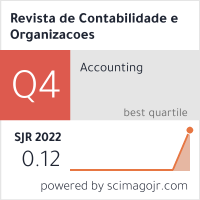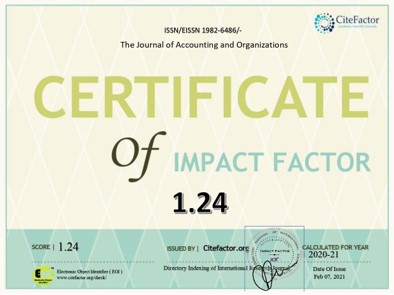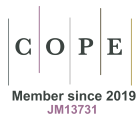The influence of performance measurement systems on organizational agility and open innovation
DOI:
https://doi.org/10.11606/issn.1982-6486.rco.2022.193897Keywords:
Performance measurement system, Organizational agility, Open innovation, Brazilian firmsAbstract
This study analyzed the influence of Performance Measurement Systems (PMS) on organizational agility and open innovation. The data was collected from managers of Brazilian companies listed on the country’s stock exchange Brasil, Bolsa, Balcão (B3), and 105 valid responses were obtained. The analysis was conducted using structural equation modeling, and the results showed that interactive PMS positively influences organizational agility and open innovation. Also, it was observed that organizational agility mediates the relationship between interactive PMS and open innovation. This evidence contributes to the management literature by suggesting organizational agility as an important factor (mediator) that reinforces the effects of PMS on open innovation. In addition, it advances by proposing interactive PMS as an antecedent of open innovation.
Downloads
References
Anzilago, M., Gomez-Conde, J., & Lunkes, R. J. (2022). How do Managers use Management Control Systems in Response to Shareholder Activism? European Accounting Review. https://doi.org/10.1080/09638180.2022.2063152
Anthony, R. N. (1965). Planning and control systems: a framework for analysis. Division of Research, Graduate School of Business Administration, Harvard University.
Bedford, D. S. (2015). Management control systems across different modes of innovation: Implications for firm performance. Management Accounting Research, 28, 12-30. https://doi.org/10.1016/j.mar.2015.04.003
Bedford, D. S., Bisbe, J., & Sweeney, B. (2019). Performance measurement systems as generators of cognitive conflict in ambidextrous firms. Accounting, Organizations and Society, 72, 21-37. https://doi.org/10.1016/j.aos.2018.05.010
Bedford, D. S. (2020). Conceptual and empirical issues in understanding management control combinations. Accounting, Organizations and Society, 86, 101187. https://doi.org/10.1016/j.aos.2020.101187
Bisbe, J., & Otley, D. (2004). The effects of the interactive use of management control systems on product innovation. Accounting, Organizations and Society, 29(8), 709-737. https://doi.org/10.1016/j.aos.2003.10.010
Biswas, S. S. N., & Akroyd, C. (2022). Management control systems and the strategic management of innovation. Qualitative Research in Accounting & Management. https://doi.org/10.1108/QRAM-04-2021-0083
Breunig, K. J., Aas, T. H., & Hydle, K. M. (2014). Incentives and performance measures for open innovation practices. Measuring Business Excellence, 18(1), 45-54. https://doi.org/10.1108/MBE-10-2013-0049
Broadbent, J., & Laughlin, R. (2009). Performance management systems: A conceptual model. Management Accounting Research, 20(4), 283-295. https://doi.org/10.1016/j.mar.2009.07.004
Capon, N., Farley, J. U., Lehmann, D. R., & Hulbert, J. M. (1992). Profiles of product innovators among large US manufacturers. Management Science, 38(2), 157-169. https://doi.org/10.1287/mnsc.38.2.157
Chakravarty, A., Grewal, R., & Sambamurthy, V. (2013). Information technology competencies, organizational agility, and firm performance: Enabling and facilitating roles. Information Systems Research, 24(4), 976-997. https://doi.org/10.1287/isre.2013.0500
Chenhall, R. H., & Moers, F. (2015). The role of innovation in the evolution of management accounting and its integration into management control. Accounting, Organizations and Society, 47, 1-13. https://doi.org/10.1016/j.aos.2015.10.002
Chesbrough, H. W. (2003). Open innovation: The new imperative for creating and profiting from technology. Harvard Business Press.
Cockburn, I. M., & Griliches, Z. (1988). Industry effects and appropriability measures in the stock markets valuation of R&D and patents. American Economic Review, 78(2), 419-423.
Curtis, E., & Sweeney, B. (2017). Managing different types of innovation: mutually reinforcing management control systems and the generation of dynamic tension. Accounting and Business Research, 47(3), 313-343. https://doi.org/10.1080/00014788.2016.1255585
Ferreira, A., & Otley, D. (2009). The design and use of performance management systems: An extended framework for analysis. Management Accounting Research, 20(4), 263-282. https://doi.org/10.1016/j.mar.2009.07.003
Flamholtz, E. G., Das, T. K., & Tsui, A. S. (1985). Toward an integrative framework of organizational control. Accounting, Organizations and Society, 10(1), 35-50. https://doi.org/10.1016/0361-3682(85)90030-3
Frare, A. B., da Cruz, A. P. C., Lavarda, C. E. F., & Akroyd, C. (2021). Packages of management control systems, entrepreneurial orientation, and performance in Brazilian startups. Journal of Accounting & Organizational Change. https://doi.org/10.1108/JAOC-04-2021-0052
Gerdin, J. (2020). Management control as a system: Integrating and extending theorizing on MC complementarity and institutional logics. Management Accounting Research, 49, 100716. https://doi.org/10.1016/j.mar.2020.100716
Geroski, P. A. (1995). Market structure, corporate performance, and innovative activity. OUP Catalogue.
Gould, R. (2012). Open innovation and stakeholder engagement. Journal of Technology Management & Innovation, 7(3), 1-11. http://dx.doi.org/10.4067/S0718-27242012000300001
Grabner, I., Posch, A., & Wabnegg, M. (2018). Materializing innovation capability: A management control perspective. Journal of Management Accounting Research, 30(2), 163-185. https://doi.org/10.2308/jmar-52062
Grafton, J., Lillis, A. M., & Widener, S. K. (2010). The role of performance measurement and evaluation in building organizational capabilities and performance. Accounting, Organizations and Society, 35(7), 689-706. https://doi.org/10.1016/j.aos.2010.07.004
Hair Jr, J. F., Sarstedt, M., Ringle, C. M., & Gudergan, S. P. (2017). Advanced issues in partial least squares structural equation modeling. Sage Publications.
Harlez, Y., & Malagueno, R. (2016). Examining the joint effects of strategic priorities, use of management control systems, and personal background on hospital performance. Management Accounting Research, 30, 2-17. https://doi.org/10.1016/j.mar.2015.07.001
Henri, J. F. (2006). Organizational culture and performance measurement systems. Accounting, Organizations and Society, 31(1), 77-103. https://doi.org/10.1016/j.aos.2004.10.003
Henri, J. F., & Wouters, M. (2020). Interdependence of management control practices for product innovation: The influence of environmental unpredictability. Accounting, Organizations and Society, 86, 101073. https://doi.org/10.1016/j.aos.2019.101073
Huang, H. C., Lai, M. C., Lin, L. H., & Chen, C. T. (2013). Overcoming organizational inertia to strengthen business model innovation: An open innovation perspective. Journal of Organizational Change Management, 26(6), 977-1002. https://doi.org/10.1108/JOCM-04-2012-0047
Liao, S., Liu, Z., & Ma, C. (2019). Direct and configurational paths of open innovation and organisational agility to business model innovation in SMEs. Technology Analysis & Strategic Management, 31(10), 1213-1228. https://doi.org/10.1080/09537325.2019.1601693
Lill, P., Wald, A., & Munck, J. C. (2021). In the field of tension between creativity and efficiency: a systematic literature review of management control systems for innovation activities. European Journal of Innovation Management, 24(3), 919-950. https://doi.org/10.1108/EJIM-11-2019-0329
Lu, P., Yuan, S., & Wu, J. (2017). The interaction effect between intra-organizational and inter-organizational control on the project performance of new product development in open innovation. International Journal of Project Management, 35(8), 1627-1638. https://doi.org/10.1016/j.ijproman.2017.09.009
Malmi, T., & Brown, D. A. (2008). Management control systems as a package — Opportunities, challenges and research directions. Management Accounting Research, 19(4), 287-300. https://doi.org/10.1016/j.mar.2008.09.003
Merchant, K. A., & Otley, D. T. (2007). A review of the literature on control and accountability. Handbooks of Management Accounting Research, 2, 785-802.
Mannes, S., & Beuren, I. M. (2021). Influência da capacidade de rede e do compartilhamento de informações e de conhecimento na inovação aberta. Advances in Scientific and Applied Accounting, 14(2), 164–178/179. https://doi.org/10.14392/asaa.2021140207
Mannes, S., Frare, A. B., & Beuren, I. M. (2021). Efeitos do uso dos orçamentos estático e flexível na inovação de processos e produtos. Revista de Contabilidade e Organizações, 15, e180829-e180829. https://doi.org/10.11606/issn.1982-6486.rco.2021.180829
Mikalef, P., & Pateli, A. (2017). Information technology-enabled dynamic capabilities and their indirect effect on competitive performance: Findings from PLS-SEM and fsQCA. Journal of Business Research, 70, 1-16. https://doi.org/10.1016/j.jbusres.2016.09.004
Moerloose, C. (2000). Turning innovation into success. European Business Forum, 1.29–35.
Monteiro, J. J., & Beuren, I. M. (2020). Efeitos do debate do sistema de mensuração de desempenho e do conflito cognitivo na inovação ambidestra. Revista de Contabilidade e Organizações, 14. https://doi.org/10.11606/issn.1982-6486.rco.2020.170418
Moulang, C. (2015). Performance measurement system use in generating psychological empowerment and individual creativity. Accounting & Finance. 55( 2), 519-544, 2015. https://doi.org/10.1111/acfi.12059
O’Sullivan, D., & Dooley, L. (2009). Applying Innovation. Sage Publications Inc., Thousand Oaks.
Pfister, J. A., Jack, S. L., & Darwin, S. N. (2017). Strategizing open innovation: How middle managers work with performance indicators. Scandinavian Journal of Management, 33(3), 139-150. https://doi.org/10.1016/j.scaman.2017.06.001
Simons, R. (1987). Accounting control systems and business strategy: An empirical analysis. Accounting, Organizations and Society, (12)4, 357–374, https://doi.org/10.1016/0361-3682(87)90024-9
Simons, R. (1990). The role of management control systems in creating competitive advantage: New perspectives. Accounting, Organizations and Society, 15(1-2), 127–143. https://doi.org/10.1016/0361-3682(90)90018-P
Simons, R. (1991). Strategic orientation and top management attention to control systems. Strategic Management Journal, 12(1), 49-62. https://doi.org/10.1002/smj.4250120105
Simons, R. (1995). Levers of control: How managers use innovative control systems to drive strategic renewal. Boston: Harvard Business School Press.
Simons, R. (2000). Performance measurement and control systems for implementing strategy. Upper Saddle River: Prentice Hall.
Teece, D., Peteraf, M., & Leih, S. (2016). Dynamic capabilities and organizational agility: Risk, uncertainty, and strategy in the innovation economy. California Management Review, 58(4), 13-35. http://dx.doi.org/10.1525/cmr.2016.58.4.13.
Trinh-Phuong, T., Molla, A., & Peszynski, K. (2010). Enterprise systems and organisational agility: Conceptualizing the link. 21st Australasian Conference on Information Systems.
Widener, S. K. (2007). An empirical analysis of the levers of control framework. Accounting, Organizations and Society, 32(7-8), 757-788. https://doi.org/10.1016/j.aos.2007.01.001
Downloads
Published
Issue
Section
License
Copyright (c) 2022 Evellin Ramlow Brüggemann, Januário José Monteiro, Rogério João Lunkes

This work is licensed under a Creative Commons Attribution-NonCommercial-NoDerivatives 4.0 International License.
The RCO adopts the Free Open Access policy, under the standard Creative Commons agreement (CC BY-NC-ND 4.0). The agreement provides that:
- Submission of text authorizes its publication and implies commitment that the same material is not being submitted to another journal. The original is considered definitive.
- Authors retain the copyright and grant the journal the right of first publication, with the work simultaneously licensed under the Creative Commons Attribution License which allows the sharing of the work with acknowledgment of authorship and initial publication in this journal.
- Authors are authorized to take additional contracts separately, for non-exclusive distribution of the version of the work published in this journal (e.g. publish in an institutional repository or as a book chapter), with necessary recognition of authorship and initial publication in this journal.
- Authors are allowed and encouraged to publish and distribute their work online (e.g. in institutional repositories or on their personal page) before or during the editorial process, as this can generate productive changes as well as increase the impact and citation of published work (See The Effect of Free Access).
- The journal does not pay copyright to the authors of the published texts.
- The journal's copyright holder, except those already agreed in the Free Open Access Agreement (CC BY-NC-ND 4.0), is the Accounting Department of the Faculty of Economics, Administration and Accounting of Ribeirão Preto of the University of São Paulo.
No submission or publication fees are charged.
Up to 4 authors per article are accepted. Exceptionally duly justified cases may be reviewed by the Executive Committee of the RCO. Exceptional cases are considered as: multi-institutional projects; manuscripts resulting from the collaboration of research groups; or involving large teams for evidence collection, construction of primary data, and comparative experiments.
It is recommended that the authorship be ordered by contribution of each of the individuals listed as authors, especially in the design and planning of the research project, in obtaining or analyzing and interpreting data, and writing. Authors must declare the actual contributions of each author, filling the letter to the editor, at the beginning of the submission, taking responsibility for the information given.
Authors are allowed to change throughout the evaluation process and prior to the publication of the manuscript. The Authors should indicate the composition and final order of authorship in the document signed by all those involved when accepted for publication. If the composition and authoring order is different than previously reported in the system, all previously listed authors should be in agreement.
In the case of identification of authorship without merit or contribution (ghost, guest or gift authorship), the RCO follows the procedure recommended by COPE.







